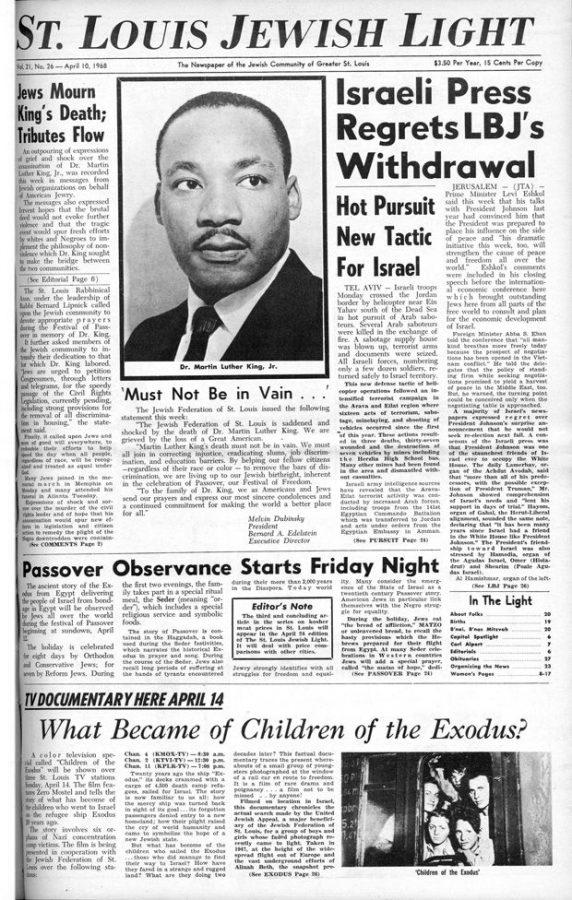From MLK to Michael Brown: The St. Louis Jewish response
Published August 27, 2014
The more things change, the more they stay the same. That old expression is certainly applicable to how the St. Louis Jewish community responded to two tragedies involving the violent deaths of two black men: the Rev. Martin Luther King Jr. in April 1968 and Michael Brown in August 2014. King, who was the premier leader of the civil rights movement, was assassinated in Memphis, Tenn., by bigoted criminal James Earl Ray. Brown, 18, who was looking forward to starting college, died of multiple gunshot wounds fired by Ferguson Police Officer Darren Wilson.
To be sure, the tragic deaths of King and Brown exhibit significant differences, but also some striking similarities. Both were African-American males killed by gunshot wounds. Both deaths set off shock waves that convulsed not just the locations of the shootings, but the entire nation. Both deaths were accompanied by good-faith efforts to pay tribute to the memories of the deceased. and both were accompanied by tremendous urban unrest.
Washington after the King shooting, with National Guard troops deployed to quiet often violent protests, resembled an occupied city. The few-block radius where the shooting in Ferguson occurred also has resembled a war zone, with searing images of militarized police facing crowds made up of peaceful protesters and violent instigators.
How did the St. Louis Jewish community react to the immediate aftermath of the murder of King, and how can the lessons learned from that event help guide our St. Louis community in restoring calm and bringing healing immediately and over a longer term?
After King’s assassination, the urgent need for a quick and compassionate community response was made apparent by violent protests escalated into major riots in city and after city – Washington, Harlem in New York City, Chicago and Detroit, as well as other urban centers. Police attempting to quell the violence were pelted with rocks, bottles and Molotov cocktails in scenes that have been replicated in Ferguson since the death of Brown.
In 1968, St. Louis County Supervisor Lawrence K. Roos and St. Louis Mayor Alphonso J. Cervantes put aside their differences and met with African-American, Jewish, Catholic, Protestant and other leaders in an effort to avoid a riot situation in St. Louis and to work toward healing. The African-American leaders they met with included “establishment” leaders such as William Douthit of the Urban League and U.S. Rep. William L. Clay, as well as more “militant” leaders such as Solomon Rooks of the Congress of Racial Equality (CORE) and Percy Green of ACTION (Action Committee to Improve Opportunities for Negroes).
All of the assembled leaders – black, white, Republican, Democrat, city, county, national – came together for the common good. A communitywide Unity March to the Arch was organized with hundreds of participants coming together downtown and gathering at the Gateway Arch for speeches, prayers and a public commitment to avoid violence and come together for the overall good of the community.
The Light carried a Page One story on the murder of King. On the second page were photos of Jewish leaders who took part in the March, including Rabbis Richard Steinbrink, Alvan Rubin Julius Nobel, and Bernard Lipnick. Local media were brought into the discussion, and many of them agreed not to provide sensationalized coverage of rumors that St. Louis was “ready to blow up” like other cities. Local Jewish leaders responded with one voice to the death of Dr. King. The late Rabbi Lipnick of B’nai Amoona, then-president of the St. Louis Rabbinical Association, called upon Jews to offer prayers during Passover in memory of Dr. King. Jewish Federation leaders issued a statement comparing King’s legacy to the message of Passover, the Festival of Freedom.
Central Reform Congregation’s Rabbis Susan Talve and Randy Fleisher have had a consistent presence at community gatherings in Ferguson. Last week, Andrew Rehfeld, president and CEO of the Federation, along with leaders of the Jewish Community Relations Council, rabbis and others, issued statements of concern and the need for healing, as well as action plans to help bring healing to Ferguson. The St. Louis County Human Relations Commission (which I staffed in 1964, and which I have chaired for many years), met Aug. 15 to bring together Jewish and general community leaders to discuss how best to deal with the crisis.
St. Louis after King’s assassination managed not only to avoid violent riots and civil unrest that occurred in other cities but was able to forge even stronger ties with local African-American leadership, including the establishment of the Black-Jewish Dialogue Group. Ten years ago, St. Louis’ Karen Kalish started Cultural Leadership, which brings together local Jewish and African-American students for a shared learning experience.
Let’s hope that the ongoing peaceful protests in Ferguson can continue for as long as needed, and that the violent troublemakers can be prevented from disrespecting the memory of Michael Brown and the expressed wishes of his parents that there be no violence.
And let us hope that the solid foundation of good will between the Jewish and African-American communities can help bring about community peace, harmony and concrete actions to ensure healing and efforts to improve not only Ferguson but our entire community in the years ahead.















